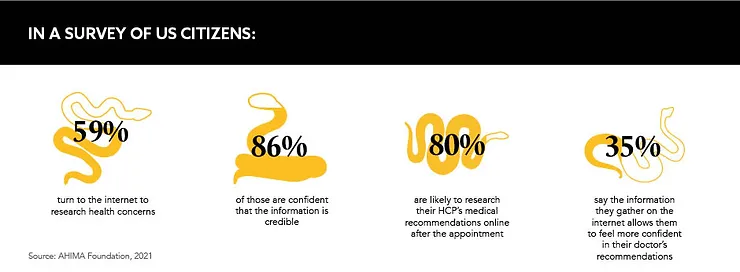Navigating the complex world of the internet and social media can at times feel like traversing a jungle. How can pharma marketers become intrepid explorers and guide patients through the undergrowth?
Words by Jade Williams
As the digital marketing landscape evolves, pharmaceutical companies are turning their attention toward the kings and queens of the online jungle: influencers. But as the internet – and social media in particular – require careful navigation, how can companies leverage different platforms to guide online-savvy patients through the twisting trails of the internet?
The growth of Dr Google
It can be hard to resist hunting for more information once a diagnosis has been given, but even more so to stop reading once an interesting source of information has been unearthed, even if it’s an unreliable one.
“People continue to turn to Dr Google,” says Ridwaan Jhetam, Senior Vice President, Head of Worldwide Medical Affairs Hematology, Bristol Myers Squibb, at Reuters Events: Customer Engagement Europe 2022. “They live and depend on the internet as their first port of call. It is available on demand 24/7.”
To combat the risk of misinformation, Jhetam suggests that pharma companies employ ‘search listening’ to gather insights on searches to understand what patients want to know about their diagnoses or prescriptions. In turn, they can arm healthcare professionals with the right knowledge and resources to eliminate potential concerns before patients set out into the social media jungle alone, where they may fall prey to fake or biased health content.
Snakes and ladders
Julia Walsh, CEO, Brand Medicine International, notes: “If we, as an industry, are not turning up with evidence-based, patient-responsive content, we inadvertently create a vacuum where misinformation can fester.” Also speaking at the Reuters’ event, she illustrates this by referring to what she calls a ‘super reviewer’. This is “one patient who’s powerful and compelling first-person story about their [often negative] experience of a product is turning up [online] again, again and again”, she explains. The result? Cases of primary non-adherence in those viewing this content.
Bridging the gap between being respectful of patients’ lived experiences and retaining a positive brand image online can be a treacherous task, but it is certainly beneficial if executed correctly. While patients are entitled to post whatever they wish about a brand’s products, directly telling people not to fill prescriptions or take their medicines could inadvertently put lives at risk. Patients could even see this negative information online and take it to their patient groups, causing widespread adherence issues, demonstrating an “upstream influence of downstream interactions”, Walsh adds.
Build a relationship rather than engaging in a series of transactions
If an issue with a super reviewer arises, companies have the option to collaborate with Google on a solution. Walsh suggests: “Reporting them to Google and leveraging the Google philosophy of ‘Your Money or Your Life’.” This is the search engine’s promise to deprioritise content that is adversely impacting someone’s health or putting them at financial risk. Deprioritisation will ensure the user’s posts do not appear at the top of search queries, therefore preventing patients from being discouraged from taking their medication and spreading any potential misinformation further.
Although some super reviewers may drive non-adherence, not all online influencers can be damaging to a brand’s reputation. With the increased prevalence of social media use over the past two years, and a heightened awareness of health since the pandemic, influencers are increasingly shaping healthcare conversations. Data from LinkedIn published in 2021 shows there has been a 28% year-on-year increase in conversations on the platform on topics such as medicine, health and wellbeing. Pharma companies would be wise to take note of this and seek opportunities to form positive connections with patients driving these conversations.

Branching out
Another challenge to connecting with patients online is finding them. Seeking patients out via social media may be harder than expected but connecting with those already in patient groups and forums is more straightforward. Understandably, upon diagnosis people often seek out others experiencing their conditions to gain insight from lived experiences – as opposed to relying on the often clinical leaflets received from HCPs – leading them to join online communities of people who share their disease.
Finding online pockets of patients is one piece of the puzzle, but how is pharma expected to connect with them? Speaking at Reuters Events: Pharma Clinical 2022, Michele Rhee, Vice President of Patient Affairs and Advocacy, X4 Pharma, notes that marketers must remember to build “a relationship rather than engaging in a series of transactions to accomplish a goal or series of goals”. She recommends sharing as many resources as possible with patient groups before initiating a social media partnership. “The baseline is to always give a hand before you get a hand,” she asserts.
However, Rhee warns that when finding a social media user to connect with, whether they are part of a patient group or otherwise, pharma professionals must be mindful that people are posting “for themselves” and “not as a signal for someone else or a company to reach out to them”. Patients who post about their experiences and potential hardships online are not likely to be seeking attention from large corporations, so companies must be careful to approach contact with caution, so patients do not feel like their privacy has been invaded.
To truly walk together with patients through the online jungle, pharma must always have empathy at the forefront of their minds. Relationships with patients and influencers must be built on a strong foundation of trust and understanding, otherwise there will be little value to be created or claimed for either side.










